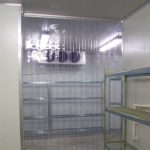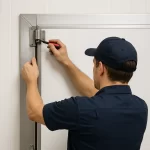How to Determine the Right Coolroom and Freezer Temperature for your Products
- 06 May 2015
Temperature is a considerable factor when selecting a coolroom or freezer. While a coolroom is intended to keep its contents cool (like a home fridge), a freezer must actually freeze the contents and maintain a temperature below zero.
Coolrooms and freezers must be constructed in accordance with Health Department standards. Freezers require more wall insulation and different floor construction than coolrooms. High thermal and insulation panels control temperature and humidity. Sandwich-type panels made of continuous lamination that bonds sturdy aluminium or colorbond to both sides of a polystyrene core is a preferred construciton. This type of panel is strong, durable, and provides long-lasting hygienic storage, operation, and resistance to mold and bacteria. It also alleviates future need for time-consuming protective painting. Vermin control, coving, and industry-specific silicone sealants standards must also be met.
There are State and federal government incentive programs available to help cover some of the costs of upgrading or replacing facilities to more energy-efficient versions.
Coolroom Design/Selection
Realistically determine the refrigerated space the business actually needs. Poorly designed systems tend to have the lowest capital costs, highest operating costs, and shortest useful life.
Oversized rooms or equipment consume more initial capital- and ongoing energy-costs. Oversized compressor motors and undersized evaporators/condensers (heat rejection) consume more energy and capital.
Also consider added design features that increase the initial cost, running cost savings over the expected life of the room / system, the environmental warming impact (TEWI), and the life-cycle cost (LCC). Also pay close attention to part-load energy performance.
Refrigerant options such as R134a that use less power and higher GWP than most other HFCs and traditional synthetic refrigerants recoup their higher initial cost in the first few years. Benefits of using natural refrigerant alternatives, such as carbon dioxide, ammonia, and hydrocarbons are: good overall energy efficiency, zero ozone depletion potential (ODP), low global warming potential (GWP), and environmentally-friendly and levy-free status.
Secondary refrigerants may reduce primary refrigerant charges and pumping power while improving humidity control.
Additional coolroom and freezer Best-Practice options targeting temperature control include:
• thicker insulation and fast-closing automatic doors,
• highly efficient refrigeration plant with variable-speed compressors and fans,
• reduced temperature differences across heat exchangers,
• reduced compression ratios, dual-stage compression,
• low-energy LED lighting,
• leak-tight pipe installation, and
• desuperheaters, and modern control and defrost strategies.
Managing and Reducing Thermal Loss
Air-tight insulation eliminates infiltration of warm moist outdoor air. Vapor barriers reduce refrigeration loads. Refrigerated product adds thermal mass to minimize system runtime and cycling.
• Optimize the storage capacity (66% for coolrooms; 75% for freezers);
• Install a variable-speed compressor (do not block evaporator airflow;
• Regularly calibrate thermometer/thermostat/controller and gauges;
• Check automatic electric defrost timer settings;
• Install a power meter;
• Upgrade controls with direct digital control (DDC) panels.
Reflective and thermal coatings, compact fluorescents/LED lighting systems reduce energy consumption and internal heat loads.
Maintenance and Replacement
Repair leaks, monitor refrigerant levels, and be suspicious of refrigerant top-ups. Intentional (poorly maintained systems) refrigerant emission is illegal.
Energy-efficient interventions should only be performed by qualified engineers (M.AIRAH) and licensed technicians.
Where CFC (R12) and HCFC (R22, R502) based systems are old or rundown, replacement with a modern energy-efficient solution is usually the best long-term option.
Mark Connelly
C&M Coolroom Services
E-mail : markconnelly@cmcoolrooms.com.au
Mobile: 0412 536 315


